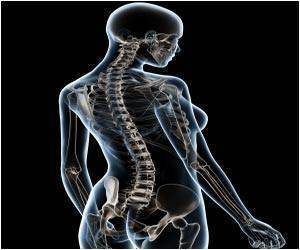Currently patients diagnosed with scoliosis are either monitored for progression, treated with a brace, or, in severe cases, offered surgery.

‘Specialized physical therapy exercises can improve the curve of the spine, muscle endurance and quality of life in teens with scoliosis.’





For teens with scoliosis, a new study shows specialized physical
therapy exercises can improve the curve of the spine, muscle endurance
and quality of life, as researchers advocate for conservative management
to be added to the standard of care for patients in Canada. Sanja Schreiber from the University of Alberta's Faculty of Rehabilitation Medicine, explained, "Our study showed that 88% of patients who did the Schroth physiotherapeutic scoliosis-specific exercises showed improvements or prevented progression in their scoliosis curves over six months compared to 60% in the group receiving only standard of care."
For 14-year-old Ava who had to wear a brace for her scoliosis since she was 11, the scoliosis-specific exercises, Schroth, have meant less pain, more confidence and more control over her own body. "I don't have to look like I'm crooked for the rest of my life. I now have control over my own body," she said. "While my brace is very important, the exercises have helped me change my outlook on my condition."
The randomized control trial, recently published in PLOS ONE, studied 50 adolescents with scoliosis aged 10 to 18 years with curves of 10 to 45 degrees (Cobb Angle). After six months of Schroth physiotherapy, (30-45 minute daily home program and weekly supervised sessions), 88% of patients either had improving curves beyond or remaining within five degrees of their baseline curve magnitude. The average curve in the control group deteriorated by 2.3 degrees. Overall, the difference between the Schroth and the control group was 3.5 degrees.
"These short term results are clinically significant and show that Schroth physiotherapy exercises could help many patients with scoliosis if this type of conservative management is added to the standard of care," said Eric Parent, associate professor of physical therapy, Faculty of Rehabilitation Medicine. The results have justified further research, with the establishment of the Multicenter Schroth Exercise Trial.
Advertisement
"The current standard of care for smaller curves is very much 'wait and see' while parents and patients demand a more proactive approach. I'd like to encourage them to 'try and see,'" Schreiber continued. "Try Schroth and see if it helps. Not only in our study, but also in my clinical practice, I've seen so many teens who have experienced pain improvement and feel better overall with Schroth exercises. Also, they feel they are in control of their scoliosis, because the Schroth method teaches them how to stand, sit, walk, and do other daily activities correctly, so that they can keep their best posture. It's just better quality of life overall."
Advertisement
"I used to get a lot of pain and felt really weak without my brace. Now I have gained strength and hold myself up with my own muscles," she said.
The study also showed positive effects the Schroth had on pain, body image and muscle endurance. "The Schroth group showed improved muscle endurance by increasing the average holding time by 32.3 seconds after three months, while the controls increased by only 4.8 seconds," said Parent.
For Ava, the change in perspective is what she values most throughout her experience.
"I used to think I'd be this way forever and there's nothing I can do to fix it. But now I have control over my own body, and I know I don't have to feel that kind of pain for the rest of my life."
Source-Eurekalert














